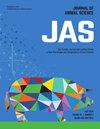Maternal supplementation of a Bacillus-based direct-fed microbials altered the cow prepartum plasma metabolome and the calf plasma metabolome before and after vaccination.
IF 2.9
2区 农林科学
Q1 AGRICULTURE, DAIRY & ANIMAL SCIENCE
引用次数: 0
Abstract
This study evaluated the effects of maternal supplementation of a Bacillus-based direct-fed microbial (DFM) on the plasma metabolome of cow-calf pairs. At the start of the study (day 0), 72 pregnant Brangus crossbred beef heifers (20 to 22 months of age) were stratified by body weight (BW; 431 ± 31 kg) and body condition score (6.0 ± 0.36) and randomly allocated into 12 bahiagrass pastures (1 ha and 6 heifers/pasture). Treatments were assigned to pastures (6 pastures/treatment) and consisted of heifers supplemented with 1 kg/head/day (DM basis) of soybean hulls, either alone (CON) or combined (BAC) with DFM containing a mix of Bacillus subtilis and B. licheniformis (Bovacillus; Novonesis, Hørsholm, Denmark) from day 0 to 242 (139 ± 4 days prepartum until 104 ± 4 days postpartum). Calves were weaned on day 242 and then allocated to drylot pens and fed the same diet until day 319. On days 271 and 287, calves were vaccinated against pathogens associated with bovine respiratory disease. Blood samples were collected from all heifers on days 0 and 63 (prepartum) and from all calves on days 271 (pre-vaccination), 274 (during the inflammatory response), and 287 (post-inflammatory response) to assess the plasma concentration of metabolites. There was a separation on day 63 (R2 = 0.96) for the plasma metabolome profile of BAC and CON heifers. Heifers fed BAC had increased (P ≤ 0.05) plasma concentration of 17 metabolites, including glycerophospholipids and amino acids, but decreased (P ≤ 0.05) plasma concentration of 4 triacylglycerols. Eight pathways related to amino acids metabolism were increased (P ≤ 0.01) in BAC vs. CON heifers. For the calf metabolome, a separation was observed on days 271 (R2 = 0.95), 274 (R2 = 0.95), and 287 (R2 = 0.99). Supplementation with BAC decreased (P ≤ 0.05) plasma concentrations of 3 and 6 metabolites from amino acids and triacylglycerols on days 271 and 274, respectively, and increased (P ≤ 0.05) plasma concentrations of 9, 10, and 28 metabolites associated with amino acids and lipids metabolism on days 271, 274, and 287, respectively. Maternal supplementation with Bacillus-based DFM altered calf amino acid metabolism before vaccination (P ≤ 0.03) but enhanced pathways associated with immune response after vaccination (P ≤ 0.05). Thus, maternal supplementation of a Bacillus-based DFM modified the maternal prepartum metabolome and the calf metabolome before, during, and after a vaccination-induced inflammatory response.母体补充一种芽孢杆菌直接喂养的微生物改变了接种前后奶牛预备血浆代谢组和犊牛血浆代谢组。
本研究评估了母体添加一种芽孢杆菌直接饲喂微生物(DFM)对奶牛-犊牛对血浆代谢组的影响。试验开始(第0天),选取72头20 ~ 22月龄的妊娠布兰格斯杂交肉牛,按体重(BW;体重(431±31 kg),体况评分(6.0±0.36),随机分配到12个百喜草牧场(1公顷,6头/草场)。每个处理分配到牧场(6个牧场/处理),分别在小母牛的基础上添加1 kg/头/天(DM)大豆皮,单独(CON)或联合(BAC)添加含有枯草芽孢杆菌和地衣芽孢杆菌(Bovacillus;nonovonesis, Hørsholm, Denmark),从第0天至第242天(产前139±4天至产后104±4天)。第242天断奶,分配至旱地栏,饲喂相同饲粮,直至第319天。在第271天和287天,小牛接种了与牛呼吸道疾病相关的病原体疫苗。在第0天和第63天(准备期)采集所有母牛的血液样本,并在第271天(接种前)、第274天(炎症反应期间)和第287天(炎症反应后)采集所有小牛的血液样本,以评估代谢物的血浆浓度。BAC和CON犊牛的血浆代谢组谱在第63天分离(R2 = 0.96)。饲喂BAC后,17种代谢物(包括甘油磷脂和氨基酸)血浆浓度升高(P≤0.05),4种甘油三酯血浆浓度降低(P≤0.05)。BAC与CON相比,8条与氨基酸代谢相关的途径增加(P≤0.01)。犊牛代谢组分离发生在第271天(R2 = 0.95)、第274天(R2 = 0.95)和第287天(R2 = 0.99)。在第271天和第274天,添加BAC分别降低了3种和6种氨基酸和甘油三酯代谢物的血浆浓度(P≤0.05);在第271、274和287天,添加BAC分别提高了9种、10种和28种氨基酸和脂质代谢相关代谢物的血浆浓度(P≤0.05)。母体补充芽孢杆菌DFM改变了接种前犊牛氨基酸代谢(P≤0.03),但增强了接种后免疫应答相关通路(P≤0.05)。因此,母体补充一种芽孢杆菌基DFM改变了母体预备代谢组和小牛代谢组,在接种疫苗诱导的炎症反应之前、期间和之后。
本文章由计算机程序翻译,如有差异,请以英文原文为准。
求助全文
约1分钟内获得全文
求助全文
来源期刊

Journal of animal science
农林科学-奶制品与动物科学
CiteScore
4.80
自引率
12.10%
发文量
1589
审稿时长
3 months
期刊介绍:
The Journal of Animal Science (JAS) is the premier journal for animal science and serves as the leading source of new knowledge and perspective in this area. JAS publishes more than 500 fully reviewed research articles, invited reviews, technical notes, and letters to the editor each year.
Articles published in JAS encompass a broad range of research topics in animal production and fundamental aspects of genetics, nutrition, physiology, and preparation and utilization of animal products. Articles typically report research with beef cattle, companion animals, goats, horses, pigs, and sheep; however, studies involving other farm animals, aquatic and wildlife species, and laboratory animal species that address fundamental questions related to livestock and companion animal biology will be considered for publication.
 求助内容:
求助内容: 应助结果提醒方式:
应助结果提醒方式:


